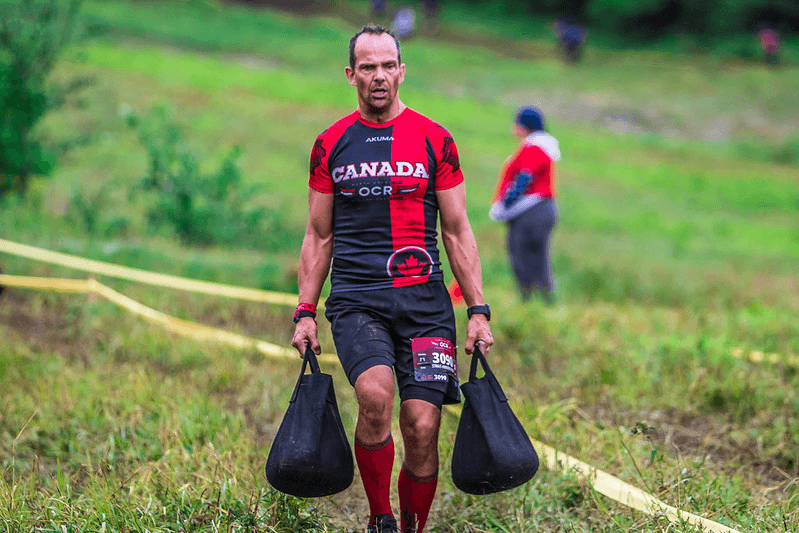
How to Train for the OCRWC: Heavy Carries and Hills
Let’s talk about a concern for many, the elevation and heavy carries. Stratton Mountain Resort, the home of 2018 and 2019’s North American Obstacle Course Racing Championships (NORAM) has more than 2,000 feet (600 meters) of elevation gain between the foot and the summit. This means you are going to have to move your body from the base of the mountain all the way to the top, possibly multiple times when you show up to race the 2022 OCR World Championships.

To prepare for this feat, OCR athletes want to work on our ability to climb and the best way to do that is to practice climbing mountains. There are infinite combinations of hill workouts you can do, so I reached out to some OCR trainers that many of my friends and fellow OCR athletes use for workouts: Yancy Culp of Yancy Camp and Jared Renyer of JRen Fitness for a workout you can do to help you prepare for OCRWC.
If you are concerned because you don’t have any hills near you, don’t worry. You can always “bring the hill to you” with smaller hills, treadmills or through the use of dragging a tire to simulate the leg fatigue of hill climbing.
Yancy Culp’s Yancy Camp Hill Workout

This workout can be completed inside or outside. Logistically it’s easier to complete inside on a treadmill, but if you’re like Yancy, you like to get outside as much as possible.
Phase 1 – Warm-up: 15% incline x 6min at low end zone 3 aerobic effort
Phase 2:
15% incline w/heavy carry x 2min at zone 3 aerobic effort
15% incline x 2min at zone 3 aerobic effort
15% incline w/heavy carry x 2min at above lactate threshold effort
15% incline x 2min at above lactate threshold effort
No incline x 2min at zone 3 aerobic effort
No incline x 2min at above lactate threshold effort
This completes 1 round.
Continue repeating but increase time for all 6 sections to 3min for round 2 & increase to 4min for round 3.
Total time for Phase 2 will be 54min. If you are limited on time, you can stop after round 2 for a total of 30min.
Bonus: After each round complete the following
Pull-up x 2 to hand position change x 12 to shoulder taps x 8 to hip slaps x 4 to hang until forced to drop
*If you don’t know your lactate threshold heart rate, you can go by feel. Once you hit your LT, you’re at the point where your body is accumulating lactate in your blood faster than can be removed – aka, you’re no longer working at a comfortable pace. Periodic training above your LT will improve your LT. Example – Let’s say your current LT is 165 beats per minute (bpm). With training, you increase it to 168. Now you’re running relatively comfortably at 165-167 where in the past you were running on borrowed time at 165-167. Long story short, you’re running and climbing pace out on course has improved.
Jared Renyer’s JRen Fitness Workout

Jared provided us with a five-day plan really targeting your legs. Simple, effective and efficient, here is what some of his hill workouts look like:
Day 1: Treadhill – carries 25-35 minutes total 5 minute carry with the sand bag up an incline of 7 or greater 3 minutes with no sand bag up the same incline, the repeat the cycle for the duration of the workout. Increase the incline or speed with each carry interval.
Day 2: Walkabout – load a heavy back pack and go for a 60 min walk on a preferably hilly route, if you have access to unpaved trails that is preferable. Careful with your footing.
Day 3: Rest
Day 4: Hills – Find a large hill (lake dams work well) spend 45-60 minutes sprinting up and/or carrying objects up the incline. The walk down is the rest period.
Day 5: Long Slow Distance (LSD) run based on the level of the athlete.
Conclusion
These workouts are just the tip of the iceberg, but they give you an idea of some workouts you can do to prepare for the hills and heavy carries. You are also going to want a good pair of shoes so you can attack both uphill and downhill sections with confidence. Inov-8 has a full line of great OCR shoes including their Graphene shoe.

As you continue in your training be sure to make it progressive by adding weight, time or distance to some of your training, preferably only changing one of those factors at a time. As a final note, make sure you take rest days to recover and consolidate your gains. If you want more specific or customized training aligned with your specific goals and current weaknesses, feel free to contact any of the trainers mentioned above – they’re all dedicated to OCR athletes.
Evan “Ultra-OCR Man” Perperis, NSCA-CPT, is an athlete on the Conquer The Gauntlet Pro Team, the author of six books on Obstacle Course Racing and known for his record setting multi-day OCR events for charity. Included in his 58 podium finishes is a 2nd place Pro Coed Team at the 2018 North American OCR Championships and 1st Place Team at 2018 World’s Toughest Mudder. Find more of his content at www.teamstrengthspeed.com.
Want more great training tips? Look throughout the OCRWC Blog page for more articles in the “How to Train for the OCRWC” series and pick up a copy of Evan’s newest training book “The New Strength & Speed’s Guide to Elite Obstacle Course Racing” or if you are more ultra-focused like Evan is “Mud Run Guide’s Ultra-OCR Bible”.



